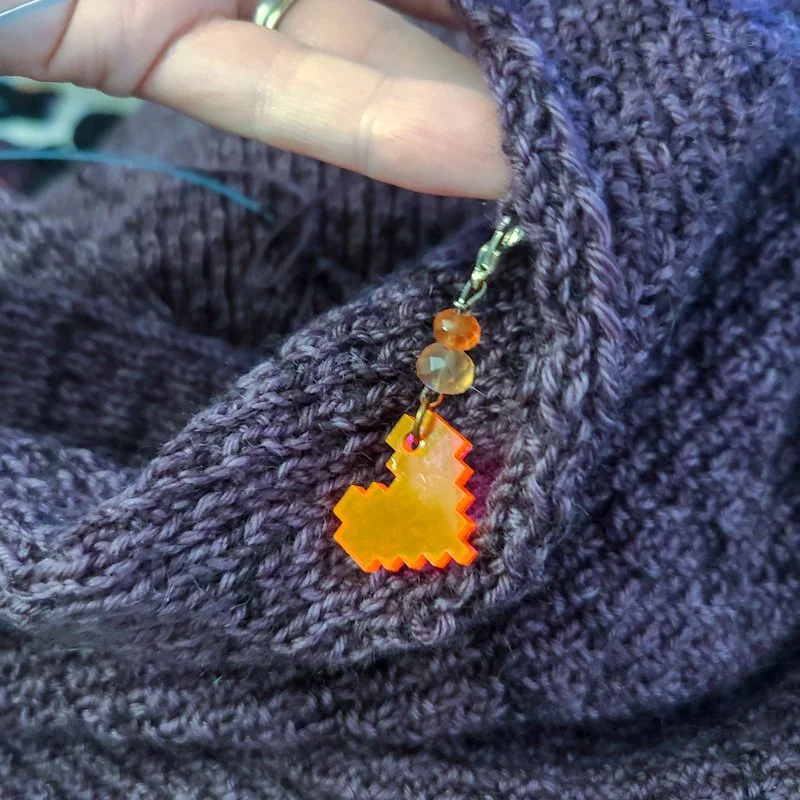The FOlio: Maema and The Big Cozy Cardigan
In the FOlio, I reflect on a finished knitting object and what the process of knitting it taught me.
Pattern 1 : Maema Cardigan (Designer Website Link)
Designer: Megan Nodecker, Pip&Pin (@pipandpin on Instagram)
Yarn Used : Fuzz Family for Kraeo Little Sister Fingering in a special National Parks colorway (this was for a series offered by Indie Handmade and no longer available, but here’s a link to the Kraeo shop)
Knit from : May 2021 to April 2022
Pattern 2 : Big Cozy Cardigan (Designer Website link)
Designer: Andrea Mowry (@dreareneeknits on Instagram)
Yarn Used : Beehive Yarns Dusty in Nightshade, Flora Adora Fibers Suri Silk Cloud Lace in Jewel Tones (not pictured, I haven’t reached the collar yet)
Knit from : July 2023 to ???
Lesson: How to keep knitting on a project when it’s lost its magic.
I love, love, love my Maema Cardigan – since I finished it in early 2022 it has been my most worn handknit sweater. It’s so versatile and comfortable and I get complimented on it every time I wear it. However, it was quite the slog to get it to the final cast-off. The honeycomb brioche stitch that makes up the bulk of the sweater, while stunning to look at, is an absolute pain to knit in fingering weight – like any brioche stitch, the vertical growth is slow and it’s basically impossible to drop down to fix errors, you have to frog back. After a few times when I discovered a very noticeable error several rows down and had to frog back to fix, I started being extra cautious about checking the stitch pattern mid-row, which did reduce my frogging but also slowed me down. I don’t regret knitting it at all, but I freely admit I would not knit it again. (If you like the look of this but also aren’t sure about fingering weight brioche, there is now a DK weight version of the sweater available).
It was very sunny and windy the day I tried to take finished object photos of Maema.
I’ve since run into the same problem with my Big Cozy Cardigan, which has been on the needles since last summer – I’m sure I will absolutely love this cardigan when it’s finished, but knitting broken rib in fingering weight for 30 inches has just taken me forever. Unlike Maema you can drop down to fix stitches because it’s just knit and purl, however the mistake I most commonly make is losing count on the K3, P1, and say doing K4, P1 and then getting back on track, which screws up the alignment of the entire rest of the row. When the alignment of most of one row is screwed up it is way easier to tink back than try to drop down and fix it (believe me, I’ve tested both methods on this knit).
The reason we knitters so often talk about process vs. product knitting is that we are so often confronted with the most beautiful products and have to weigh them against how frustrating or tedious the actual process of knitting them will be. And what makes a knit a slog is different for everyone – I know many other people have whipped up Big Cozy Cardigans and found them lovely, almost mindless knits because there’s no shaping and the stitch pattern is easy to remember. By contrast, I find the vintage feather and fan afghan I’m currently knitting super easy and delightful while others might find it complicated to keep track of which row you are on and where the side decreases go. A reminder, too, that it is always fine to decide you don’t want to spend any more time on the project, frog it, and move on to something else. However, if you’re stuck in a knitting slog and still committed to getting to the end of the project, here are a few tips that have helped me keep going.
1. Use progress keepers to track incremental progress
One of the ways that I wind up bogged down in a knitting project is when I feel like I’m barely making any progress when I sit down to knit on it. Sometimes I’m really not (hello, two-color brioche afghan where each very long row was really two full rows of knitting) and other times the texture is so similar from one row to the next that it’s just hard to see where I left off. The latter issue was very much the case with both Maema and the Big Cozy Cardigan. In both cases, I found attaching a progress keeper stitch marker a good way to see how much I was actually getting done. Sometimes I would move the marker every time I picked it up again and sometimes I’d leave it for an entire week or month so I could see how much progress I made in a certain amount of time. My favorite progress keeper marker, by the way is my neon red pixel heart from One Geek to Craft Them All (check her stuff out, especially if you are a sci-fi/fantasy or musical theater nerd).
Yes the marker really is that bright in person.
2. Find another way of describing how much is left to knit
With the Big Cozy Cardigan, motivating myself to get to that 30 inch height for the main sweater piece took a lot of reframing. At 10 inches, for example, I put down a progress marker and told myself, “okay we do this two more times.” Then for a while it became easier to tell myself “ok I’m going to focus on this project until I get two more inches added and then I can work on something else.” Finally, when I realized I was at 23 inches (so 7 inches away), I looked at my gauge and realized I had fewer than 50 rows left to knit and suddenly found myself re-energized; the number of rows left was now small enough that it felt reachable within a small amount of time. Reframing how you describe both how much you’ve already done and how much you have left on a project can really make a huge difference to how motivated you feel to work on it.
3. Show it to people
With both Maema and the Big Cozy Cardigan, when I would take the in progress knitting out, even in front of people who were not knitters themselves, people would go out of their way to tell me how beautiful the yarn was and how amazing the final project was going to be. To be fair, the yarn for both projects is truly stunning, hand-dyed yarn, but I’ve had similar reactions to projects worked with store-bought acrylic; sometimes when you’ve been working on a project for a long time you stop really seeing it, and having someone else tell you how cool it is can be a helpful reminder.
4. Take a timeout
Although many of us intend our knitted projects to be done for a particular event or feel more motivated if we give ourselves deadlines, when you’re knitting something that’s turned into a slog, sometimes the best thing to do is take a break. As I noted up in point 2, with the Big Cozy Cardigan I would tell myself I could stop every couple of inches and switch to something more immediately gratifying. Maema got put away for several weeks at a time on a couple different occasions when I just needed a break from it. Yes, you probably won’t be able to get it done for a specific deadline, but if you force yourself to push through to that deadline, you might be so burned out on the item you don’t even want to look at it when it’s done, much less wear it.
And yes, as of the posting of this blog I am still not fully done with my Big Cozy Cardigan, but I’ve finished the big rectangle and feel like I can push on through to [checks pattern] picking up 400 stitches for the shawl collar. Well, at least I have my motivational strategies.
Now it at least is starting to resemble a cardigan.
Have you found yourself stuck in a knitting slog? What are your favorite tips for getting through it?




